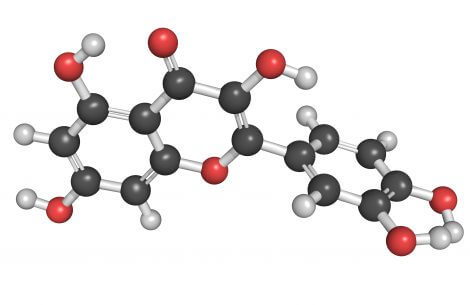When you think of good fruits, vegetables, teas, wine and herbs, you may wonder what exactly is the natural chemical that makes them what they are. And then think about those wondrous colors of flowering plants.
That’s what Flavonoids do.
Flavonoids, in a family known as polyphenolic compounds, have been cited as having many health benefits and impacts, in a wide-range of areas from medicines to cosmetics.
Flavonoids also are considered among the largest group of phytonutrients, with more than 6,000 types overall. They are plant compounds found in almost all fruits and vegetables. Flavonoids are the most abundant polyphenols in the human diet, representing about two-thirds of the ones used.
Many flavonoids are served as the active ingredients in traditional Chinese herbs, occurring virtually in all plant parts, particularly photosynthesis plant cells. Flavonoids have been historically used in Chinese medicine and also linked with protecting skin, blood sugar and blood pressure regulation and brain function.
Flavonoids also show important roles for anti-oxidation, anti-tumor, anti-inflammation systems, as well as having benefits for the neuron and bone systems.
The Chemicals
Flavonoids are also found in fruits, vegetables, grains, bark, roots, stems, flowers, tea and wine. Flavonoids are “now considered as an indispensable component in a variety of nutraceutical, pharmaceutical, medicinal and cosmetic applications, according to the Journal of Nutritional Science. “This is attributed to their anti-oxidative, anti-inflammatory, anti-mutagenic and anti-carcinogenic properties coupled with their capacity to modulate cellular enzyme function.”
Plant foods “contain thousands of natural chemicals, and the chemicals help protect plants from germs, fungi, bugs and other threats,” The American Journal of Clinical Nutrition says. Polyphenols are abundant micronutrients, and there is evidence in their role in the prevention of degenerative diseases such as cancer and cardiovascular diseases are emerging. The “health effects of polyphenols depend on the amount consumed and other factors,” the journal states.
Flavonoids and Plants
Flavonoids play a variety of roles in the biological activities in plants, animals and bacteria. They help in the growth and development of seedlings and are among the most common plant pigments next to chlorophyll and carotenoids in flowers for pollination. Flavonoids are among the plant chemicals responsible for the vivid colors in fruits and vegetables. It protects plants from different biotic and abiotic stresses.
Flavonoids for Treatment of Diseases
The root of Scutellaria baicalensis is one of the most commonly used traditional Chinese medicines for the treatment of hepatitis, tumors, diarrhea and inflammatory diseases, according to research. The major chemical constitutes of Huangqin are flavonoids.
Neurological Impacts
Recently, there has been increased attention on beneficial effects of flavonoids in neurology, including impacts of nervous system development, neuroprotection against toxin stresses. In doing so, flavonoids can help promote memory, learning and cognitive functions.
Subgroups of Flavonoids
The flavonoids can be subdivided into subgroups including flavones, flavonones, flavanones, isoflavonoids, flavanonols, fllavanols or catechins, anthocyanins and chalcones, according to the Journal of Nutritional Science.
According to the journal:
Flavones are widely found in leaves, flowers and fruits. Celery, parsley, red peppers, chamomile, mint and ginkgo biloba. Citrus fruit peels are rich in flavones.
Flavonones are linked to a number of health benefits because of their free radical-scavenging properties, and they responsible for the bitter taste of peels and juice citrus fruits They also have “antioxidant, anti-inflammatory, blood lipid-lowering and cholesterol-lowering agents.”
Isoflavonoids are in soybeans and legume plants, and have “tremendous potential to fight a number of diseases.”
Flavanols or cathechins, are found in bananas, apples, blueberries, peaches and pears.
Anthocyanins are the pigments that result in the color of plants, flowers and fruits. They are found outer layers of various fruits such as cranberries, black currants, red grapes, merlot grapes, raspberries, strawberries, blueberries and other fruits.
Chalcones occur in tomatoes, pears, strawberries and wheat.
References:
- Manach, C, Scalbert, A, et al. Polyphenols: food sources and bioavailability. The American Journal of Clinical Nutrition. 2004. Vol. 79 Issue 5, May 2. 727-747. Doi.org/10.1093/ajcn/79.5.727. https://academic.oup.com/ajcn/article/79/5/727/4690182fla
- Panche, AN, Diwan, AD, et al. Flavonois: an overview. Journal of Nutritional Science. 2016. Doi: 10.1017/ins.2016.41 https://www.ncbi.nlm.nih.gov/pmc/articles/PMC5465813/
- Hostetler, G, Ralston R, et al. Flavones: Food Sources, Bioavailability, Metabolism and Bioactivity. Advances in Nutrition. 2017. Vol. 8, Issue 3, May. 423-435. Doi.org/10.3945/an116.012948.
- Xu, S, Zhu, K, et. al. Flavonoids, derived from traditional Chinese medicines, show roles in the differentation of neurons: Possible targets in developing health food products. Birth Defects Research, Part C, Embryo Today. 2013. Dec. 99(4) 292-9. doi.org/10.1002/bdrc.21054
- Li, T, Zhuang, S, et al. Flavonoid profiling of a traditional Chinese medicine formula of Huangqin Tang using high performance liquid chromatography. Acta Pharmaceutica Sinica B. Vol 6, Issue 2. 148-157. Science Direct. 2016.
- http://www.tuscany-diet.net/2014/01/22/flavonoids-definition-structure-classification/

